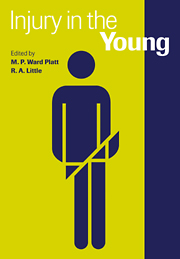Book contents
- Frontmatter
- Contents
- List of contributors
- Editors' Preface
- 1 The epidemiology of trauma involving children
- 2 Emergency room requirements for children
- 3 Child deaths in Accident and Emergency
- 4 Immediate life support
- 5 Evaluation of injury in children
- 6 Injuries of the developing brain
- 7 Wound healing in children
- 8 The lung after injury in children
- 9 Metabolic and endocrine stress responses to surgery
- 10 Head injury in children
- 11 Near drowning
- 12 The acute response to burn injury in children
- 13 Nutritional support of the severely burned child
- 14 Recovery, rehabilitation and the neuropsychological sequelae of head injury
- 15 Children's rights and child protection
- Index
4 - Immediate life support
Published online by Cambridge University Press: 18 September 2009
- Frontmatter
- Contents
- List of contributors
- Editors' Preface
- 1 The epidemiology of trauma involving children
- 2 Emergency room requirements for children
- 3 Child deaths in Accident and Emergency
- 4 Immediate life support
- 5 Evaluation of injury in children
- 6 Injuries of the developing brain
- 7 Wound healing in children
- 8 The lung after injury in children
- 9 Metabolic and endocrine stress responses to surgery
- 10 Head injury in children
- 11 Near drowning
- 12 The acute response to burn injury in children
- 13 Nutritional support of the severely burned child
- 14 Recovery, rehabilitation and the neuropsychological sequelae of head injury
- 15 Children's rights and child protection
- Index
Summary
Introduction
Trauma has surpassed infectious disease as the leading cause of childhood death and disability in the developed world (Rivara, 1982). In the UK, three children die each day and 10000 are permanently disabled as a result of trauma each year. Between the age of 5 and 14 years injury causes seven times as many deaths as leucaemia in this country (Teanby et al., 1994).
An analysis of paediatric trauma deaths over 3 years in Canada identified three major categories of preventable trauma deaths: respiratory failure, intracranial haemorrhage and inadequately treated haemorrhage. Respiratory failure was the major cause of pre-hospital deaths resulting in 19 of 42 (45%) pre-hospital deaths, with haemorrhage resulting in a further 17 of 42 (40%). In contrast, 17 of 33 (51%) of inhospital deaths resulted from potentially survivable central nervous system injury where intervention was delayed owing to failure to recognise clinical deterioration. Abdominal haemorrhage from liver or splenic injury was the cause of 15 of 33 (45%) inhospital deaths. In total, haemorrhage (predominately abdominal) accounted for 43% of all preventable deaths (Dykes et al., 1989).
The unique anatomical and physiological differences between small children and adults may lead to errors in management. The immediate care of the paediatric patient must therefore take account of these differences. Although the types of injury may vary, they often lead to common pathophysiological changes that may become life-threatening if untreated.
- Type
- Chapter
- Information
- Injury in the Young , pp. 31 - 47Publisher: Cambridge University PressPrint publication year: 1998



